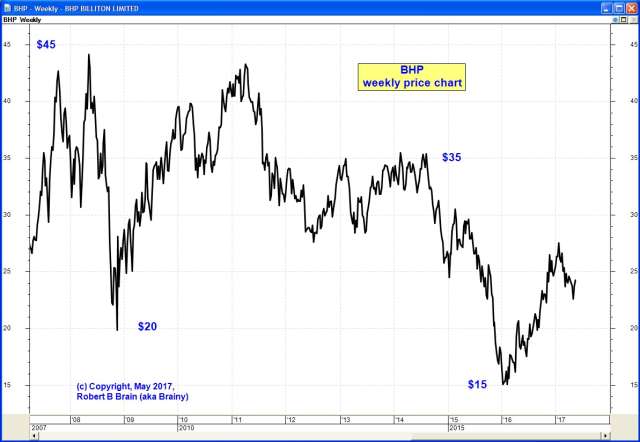
|
Brainy's Share Market Toolbox (public information) |
For a number of reasons the share market is like an elephant. Here is why...(and this is one of Brainy's Share Market GEMs)You are here: Share
Market Toolbox > Share Market
> The market is like an
elephant
Related links: Fair value (and intrinsic value); Price action context; Robert's Philosophy; Share Market GEMs; Share-Market-Ready; Nimble Short Term Investing; Funda-Technical Analysis; Sensible Investing; Contrarian Investing Redefined; Technical Analysis; |
||||
The share market is like an elephant?
The behaviour of an elephant is very similar to that of the share market:
By thinking of the market in this way, it is easier to see why we should study multiple time frames in the market, and when the market is moving strongly in one direction it might be unwise to try to argue with the market. In comparative terms, we are like an ant compared to the elephant. Some people lovingly refer to the financial markets as "Mister Market". There are three key points to remember, as follows. 1) Zoom out to see the "bigger picture"It is very useful to understand what is happening in the "bigger picture". So when studying a price chart of a stock, or index (or even any financial instrument), always zoom the chart out to see a much bigger time period. It can be surprising what is actually happening in the bigger time period. 2) Multiple time framesIt doesn't matter whether we use a trend-following (trend trading) strategy, or one of many other strategies, it is useful to know what sort of trend might be applicable to our selected instrument or stock. And, it can be very useful to know what trend might be in place in a larger time frame as well as the relatively shorter time frame. Many short-term (day) traders typically study price behaviour in two time frames - perhaps a 5-minute and a 30-minute time frame, or a 30-minute and 2-hour time frame. Longer-term traders and investors can do well to look at both daily price charts, and weekly charts, and to make sure their study includes a chart of many, many months to see where the price has come from. If we don't study both large and small time frames, 3) Mister Market is always rightIt is important to remember that even though ten brokers and analysts might give potentially different price valuations for any one stock, at the end of the day the only true and correct price valuation today is today's market price. That is the price at which the majority of actual market participants are prepared to buy or sell the stock. Any theoretical price valuation is simply not relevant. If you hold BHP shares, for example, and you believe that BHP is worth $40, and you want to hold onto the stock until someone is prepared to buy it from you at $40, then you might be waiting a long time. If the market continues to trade it at $30 to $35, then you won't be able to convince the market that it is really worth $40. This is one person's opinion. The reason that share prices move is because there are so many participants in the market who all have different opinions about what a stock is worth. (Note: the share price figures used here for BHP were first written here in 2012. BHP's share price did trade above $40 in 2008, then crashed, then above $40 again in early 2011, then fell progressively to below $35 for many months, then below $30 in 2015. See the price chart below for the sad details.) At the end of the day, the Mister Market is right. There is no point trying to argue with the market. It would be like standing in front of a stampeding herd of elephants. Weekly price chart of BHP over 10
years from 2007-2017 4) Price action context for some cluesThere is another aspect that is worthy of consideration - price action context. In much the same way that an elephant can make a move in a manner that you don't anticipate, nor understand, the market can also move in a way that you didn't expect. Remember that the share price for a stock is the agreed value that buyers and sellers have arrived at. For many stocks this value changes during the day, and finishes at one specific price at the end of the trading day. The agreed value is agreed to by the latest seller and the latest buyer. And their agreed value is based on their own interpretation or estimation of what is a fair value - it's also their own opinion. Their opinion might be based on the recommendations of one or more brokers, or market analysts, or friends or a taxi driver. It might be the consensus opinion of many brokers and analysts. However they arrive at the value, they are comfortable to make the trade at that price, based on the news and information that is available to them, and seen by them at the time. And therein lies a key consideration. That a person's opinion about a fair value for the share price is based on news and information that is available to them at the time. This might include information that is generally not available to other market participants (and might be insider trading), or it might include information that is available but which they have not seen yet. This makes it very important to try to be across the latest news and updates for a company when buying or selling the shares. Because additional new news might change your opinion about the fair value. If you have already executed the trade and the share price moves in your favour, or against you, then it can be useful to seek out any latest news which you might not have seen. Very often there will be a new announcement to the market which has caused the price movement. Because of the importance of continuous disclosure (a requirement for companies listed on the ASX securities exchange), the ASX website is the first place to look for new news and company announcements. And the ASX website has a 16-page discussion paper which explains the notion of continuous disclosure. Looking for new news, and understanding the details, can give you clues about why a price move has happened, and whether the price is likely to move further. See more details about Price Action Context here in Brainy's Share Market Toolbox. More informationFor more details on this topic, see the list of references above right... |
This is one of the many tools in Brainy's Share Market Toolbox.
The information presented herein represents the opinions
of the web page content owner, and
are not recommendations or endorsements of any product, method,
strategy, etc.
For financial advice, a professional and licensed financial advisor
should be engaged.




 The share
market (actually, perhaps the
The share
market (actually, perhaps the 